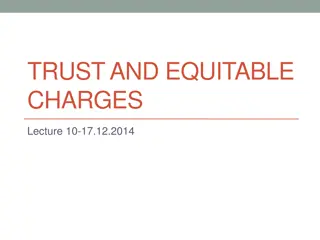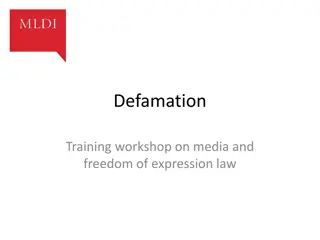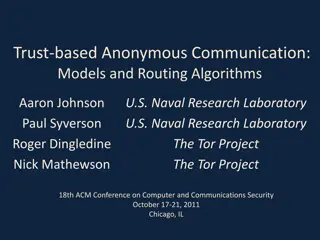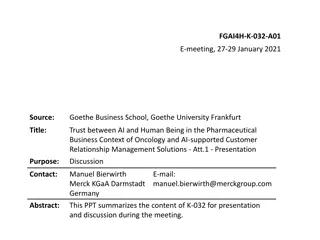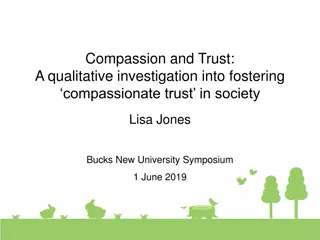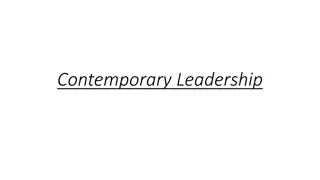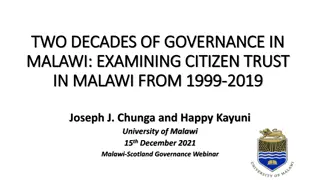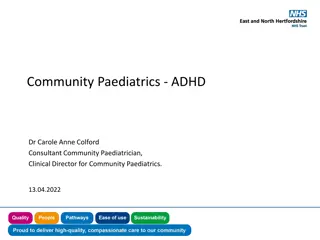Exploring Trust and Reputation Systems in Online Service Provision
Understanding trust and reputation systems is crucial for online service provision. Trust can be based on reliability or decision-making, while reputation reflects collective trustworthiness. These systems play a key role in ensuring security by providing protection against deceitful acts.
Download Presentation

Please find below an Image/Link to download the presentation.
The content on the website is provided AS IS for your information and personal use only. It may not be sold, licensed, or shared on other websites without obtaining consent from the author. Download presentation by click this link. If you encounter any issues during the download, it is possible that the publisher has removed the file from their server.
E N D
Presentation Transcript
A survey of trust and reputation systems for online service provision Audun J sang, Roslan Ismail, Colin Boyd 1
Background for trust and reputation systems Definition 1 (Reliability trust). Trust is the subjective probability by which an individual, A, expects that another individual, B, performs a given action on which its welfare depends. Problem: having high (reliability) trust in a person in general is not necessarily enough to decide to enter into a situation of dependence on that person 2
Background for trust and reputation systems Definition 2 (Decision trust). Trust is the extent to which one party is willing to depend on something or somebody in a given situation with a feeling of relative security, even though negative consequences are possible. It explicitly and implicitly includes aspects of a broad notion of trust including: dependence on the trusted entity or party reliability of the trusted entity or party utility in the sense that positive utility will result from a positive outcome, and negative utility will result from a negative outcome risk attitude in the sense that the trusting party (or trustor) is willing to accept the situational risk resulting from the previous elements 3
Background for trust and reputation systems Definition 3 (Reputation). Reputation is what is generally said or believed about a person s or thing s character or standing. The difference between trust and reputation can be illustrated by the following perfectly normal and plausible statements: (1) I trust you because of your good reputation (2) I trust you despite your bad reputation Statement (2) above reflects that the relying party has some private knowledge about the trustee, e.g. through direct experience or intimate relationship, and that these factors overrule any reputation that a person might have. 4
Background for trust and reputation systems Reputation can be considered as a collective measure of trustworthiness (in the sense of reliability) based on the referrals or ratings from members in a community. An individual s subjective trust can be derived from a combination of received referrals and personal experience. In order to avoid dependence and loops it is required that referrals be based on first hand experience only, and not on other referrals. 5
Security and trust Traditional security mechanisms will typically protect resources from malicious users, by restricting access to only authorized users. However, information providers can for example act deceitfully by providing false or misleading information, and traditional security mechanisms are unable to protect against this type of threat. Trust and reputation systems on the other hand can provide protection against such threats. Hard security or traditional mechanisms like authentication and access control, and soft security for which trust and reputation systems are examples 6
Collaborative filtering Collaborative filtering systems (CF) have similarities with reputation systems in that both collect ratings from members in a community. CF takes ratings subject to taste as input, whereas reputation systems take ratings assumed insensitive to taste as input Why: the assumption behind CF systems is that different people have different tastes, and rate things differently according to subjective taste. If two users rate a set of items similarly, they share similar tastes, and this information can be used to recommend items that one participant likes Implementations of this technique are often called recommender systems. 7
Reputation network architectures The reputation network architecture determines how ratings and reputation scores are communicated between participants in a reputation system. Centralized (e.g., eBay): a central authority derives reputation scores for each participant 8
Reputation network architectures Distributed (e.g., P2P networks) each node derives reputation scores of other nodes 9
Reputation computation engines Summation or average of ratings: Positive score minus the negative score (e.g., eBay) Average of all ratings (e.g., Amazon) Weighted average of all ratings (weights based factors such as a rater s reputation) Bayesian systems: take binary ratings as input (i.e. positive or negative) and compute reputation scores by statistical updating of beta probability density function (detail see [Josang-BECC02] next week) Discrete measures: rate performance in the form of discrete verbal statements (VT, T, UT, VUT); a trustor can weigh the raters based on discrepancy between its interaction experience vs. ratings received 10
Reputation computation engines Belief theory: A s belief in B (called an opinion) is denoted by W(A:B)=(b, d, u, a). Here b, d, and u represent belief, disbelief, and uncertainty respectively where b +d +u =1, and a is the base rate probability in the absence of evidence This opinion s probability expectation value E(W(A:B)] = b +au Subjective logic operators are used to combine opinions: Two trust paths (Alice-Bob-David, and Alice-Claire-David) can each be computed with the discounting operator The two paths can be combined using the consensus operator The end product is W(Alice:David) 11
Reputation computation engines Fuzzy logic: Reputation is represented as a fuzzy measure with membership functions describing the degrees of trust, e.g., a trust value of range [ 1.25, 1.25] denotes very low trust and so on. A node who has 0.25 trust is 75% very low trust (a membership function) and 25% low trust (another membership function) Fuzzy logic provides rules for reasoning with fuzzy measures 12
Reputation computation engines Flow model: Computing trust or reputation by transitive iteration through looped or arbitrarily long chains A participant s reputation increases as a function of incoming flow, and decreases as a function of outgoing flow Google: many hyperlinks into a web page contributes to increased PageRank whereas many hyperlinks out of a web page contributes to decreased PageRank of that web page Let P be a set of hyperlinked web pages and let u and v denote web pages in P. Let N (u) denote the set of web pages pointing to u and let N+(v) denote the set of web pages that v points to. Let E be some vector over P corresponding to a source of rank. Then, the PageRank of a web page u is: where c is chosen such that 13
Criteria for evaluating reputation computation engines Accuracy for long-term performance Distinguish between a new entity of unknown quality and an entity with poor long-term performance Weighting toward current behavior The system must recognize and reflect recent trends in entity performance Robustness against attacks The system should resist attempts of entities to manipulate reputation scores, e.g., unfair rating and ballot stuffing Smoothness Adding any single rating should not influence the score significantly 14





